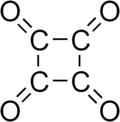Cyclobutanetetrone
Appearance

| |
| Names | |
|---|---|
| IUPAC name
cyclobutane-1,2,3,4-tetraone
| |
| Other names
tetraoxocyclobutane, cyclobutanetetrone
| |
| Identifiers | |
CompTox Dashboard (EPA)
|
|
| Properties | |
| C4O4 | |
| Molar mass | 112.040 g·mol−1 |
Except where otherwise noted, data are given for materials in their standard state (at 25 °C [77 °F], 100 kPa).
| |
Cyclobutanetetrone, also called tetraoxocyclobutane, is a hypothetical organic compound with formula C4O4 or (-(C=O)-)4, the fourfold ketone of cyclobutane. It would be an oxide of carbon, indeed a tetramer of carbon monoxide.
The compound seems to be thermodynamically unstable.[1] As of 2000, it had yet to be synthesized in significant amounts[2][3] but may have transient existence as detected by mass spectrometry.[4]
Related compounds
Cyclobutanetetrone can be viewed as the neutral counterpart of the squarate anion C4O42−, which is stable and has been known at least since 1959.[5]
The compound octahydroxycyclobutane or cyclobutane-1,1,2,2,3,3,4,4-octaol (-C(OH)2-)4 may be referred to in the literature as "hydrated tetraoxocyclobutane".[6]
References
- ^ Haijun Jiao, Gilles Frapper, Jean-François Halet, and Jean-Yves Saillard (2001), Stability of Tetraoxocyclobutane Revised: Perturbation Theory and Density Functional Scheme. J. Phys. Chem. A, volume 105 issue 24, pp. 5945–5947. DOI: 10.1021/jp010738i
- ^ Mordecai B. Rubin and Rolf Gleiter (2000), The Chemistry of Vicinal Polycarbonyl Compounds. Chemical Reviews, volume 100 issue 3, pp. 1121–1164. DOI: 10.1021/cr960079j
- ^
Gunther Seitz (1992). "Oxocarbons and pseudooxocarbons". Chemical Reviews. 92 (6): 1227–1260. doi:10.1021/cr00014a004.
{{cite journal}}: Unknown parameter|coauthors=ignored (|author=suggested) (help) - ^
Detlef Schröder, (1999). "Mass spectrometric studies of the oxocarbons CnOn (n = 3–6)". International Journal of Mass Spectrometry. 188 (1–2): 17–25. doi:10.1016/S1387-3806(98)14208-2.
{{cite journal}}: Unknown parameter|coauthors=ignored (|author=suggested) (help); Unknown parameter|month=ignored (help)CS1 maint: extra punctuation (link) - ^ Sidney Cohen, John R. Lacher, Joseph D. Park (1959) Diketocyclobutanediol. J. American Chemical Society, Vol. 81, p. 3480. DOI: 10.1021/ja01522a083
- ^ S. Skujins, J. Delderfield and G. A. Webb(1967), A mass spectrometric study of some monocyclic polycarbonyl compounds Tetrahedron, Volume 24, Issue 13, Pages 4805–4817. DOI:10.1016/S0040-4020(01)98676-4
- G. Maahs, P. Hegenberg (2003), Syntheses and Derivatives of Squaric Acid. Angewandte Chemie Int. Ed., Volume 5 Issue 10, Pages 888–893. DOI: 10.1002/anie.196608881
